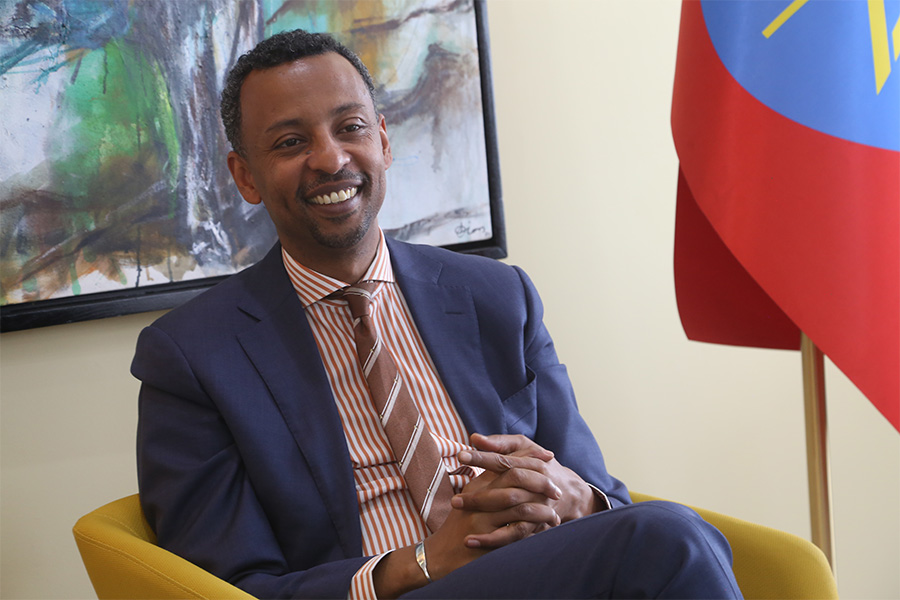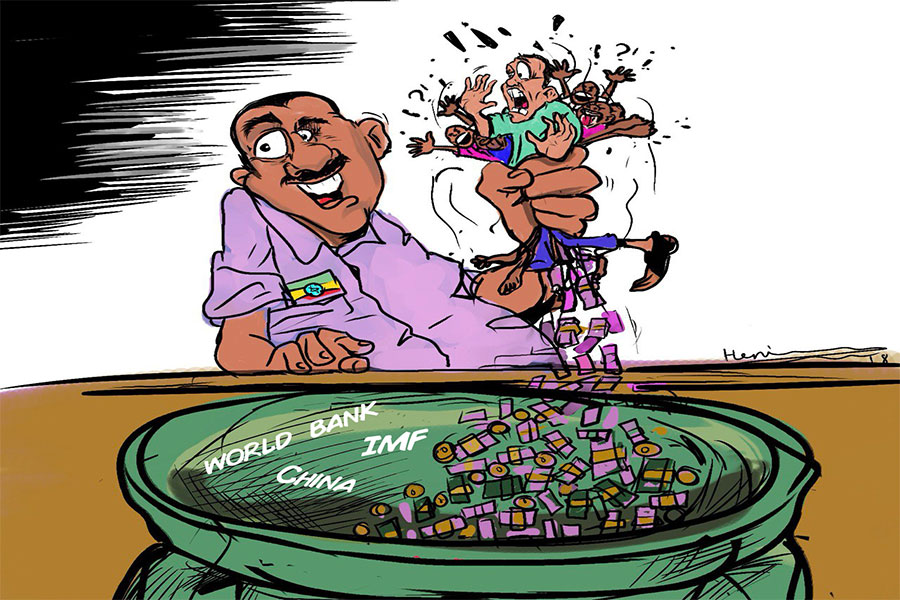
ZamZam Bank demonstrated measured growth and cautious risk management, placing it in a strong position within the niche Sharia-compliant market it pioneered as a fully-fledged interest-free financial institution. Its balanced lending strategy, robust capital buffers, and artificial intelligence (AI) initiatives mark it as a promising prospect. Nonetheless, analysts say managing liquidity pressures, curbing rising operational costs, and adapting strategically to rapidly evolving industry benchmarks remains critical for sustaining future growth and stability.
Incorporated in 2021, ZamZam Bank recently turned a corner by posting a net profit of 110.31 million Br, reversing previous losses and outperforming competitors in the emerging Sharia-compliant banking industry. Its closest competitor, Hijra Bank, trailed by nearly 10 million Br. ZamZam Bank’s net profit margin reached 17.22pc of total income, and income from financing and investments accounted for 71.7pc of operating revenue, a sign that growing customer acceptance of its Sharia-compliant banking model.
However, ZamZam’s earnings per share (EPS) stood at 5.94pc, below the minimum savings interest rate.
According to financial analysts, Sharia-compliant banks experience lower EPS, are influenced by profit-and-loss sharing models, have limited investment avenues, and higher compliance expenses.
Nonetheless, ZamZam attracted 1.9 billion Br in additional deposits, bringing its total to 6.9 billion Br during the fiscal year 2023/24. Yet, rapid deposit growth led to its interest-free financing to savings ratio dropping substantially to 67.4pc from the previous year's 87.15pc, slightly exceeding the industry average of 60.6pc recorded at the end of June 2023, indicative of careful yet assertive lending practices.
Abdulmenan Mohammed (PhD), a financial analyst based in London, cautioned against such a sharp decline, stating that it deserves management’s attention.
ZamZam's Vice President for Corporate Services, Kinde Abebe, attributed Central Bank's regulatory credit growth cap targeting inflation control to the impact on newly formed banks.
"The ratio was lower because of the cap despite excess funds," said Kinde.
Asset quality metrics show ZamZam's cautious lending strategy. Its provisions for bad loans were only 0.87pc of total financing, notably below the industry's average non-performing loan (NPLs) ratio of 3.6pc and comfortably beneath the regulatory cap of five percent.
However, its liquidity position presented mixed results. The Bank experienced a surge in foreign currency mobilisation, acquiring 30.47 million dollars during the year. Yet, total liabilities rose by 38pc, resulting in a liabilities-to-assets ratio of around 77pc, revealing potential liquidity pressures under adverse market conditions. Despite this, a healthy ratio of liquid assets — 40pc of total assets — demonstrated adequate capacity to manage deposit fluctuations.
The Bank’s total assets rose by 36pc to 9.38 billion Br, a notable deposit mobilisation and growth in its financing portfolio.
Capital adequacy remains a strong point for ZamZam Bank, reaching 35pc, far above the eight percent minimum mandated by regulators. Abdulmenan noted ZamZam held excess liquidity, calling for efficient asset utilisation.
Kinde conceded that making productive use of assets through capital formation, technological improvements, capacity building, and strategic partnerships remains a core focus.
ZamZam Bank's paid-up capital increased by 20.6pc, reaching 2.05 billion Br, but a far cry from the National Bank of Ethiopia’s (NBE) requirement of five billion Birr, with a deadline in June 2026. However, its capital positions it more resiliently than many competitors in the banking industry, whose combined capital totals 277.8 billion Br. ZamZam’s capital-to-asset ratio of 21.86pc exceeded industry benchmarks, providing a safety buffer against potential volatility.
ZamZam’s stronger capital position could provide greater flexibility in technological investments, customer acquisition, and operational improvements. Industry-wide trends show deposit growth at 30pc, average loan expansion at 27pc, and net profit growth at 32pc, revealing ZamZam’s long-term success depends on balancing prudent expansion and risk management.
According to Kinde, additional constraints, such as the absence of an interest-free banking money market platform, were notable.
"We’re focusing on short-term investments like forex dealings while looking for additional opportunities like Musharaka services," he told Fortune.
ZamZam’s revenues grew substantially during the financial year, increasing by 92pc to 857 million Br. Income from financing and investment rose by 75.6pc to 618.14 million Br, while other operating income surged by a whopping 157.5pc to 239.73 million Br. The profit distributed to Mudarabah depositors grew by 27.9pc to 10.32 million Br, yet accounted for only 1.7pc of total financing income.
Abdulmenan attributed this strong performance largely to substantial increases in financing income and extremely low costs associated with deposit mobilisation, citing them as major contributors to profitability.
“This is the smallest fraction of the proportion of interest conventional banks pay to mobilise deposits to interest income,” he told Fortune. “The substantial low level profit shared to Mudarabah depositors hugely contributed to the improved profit performance.”
Despite revenue growth, ZamZam’s rising overheads remain an issue, jumping by 42pc from the previous year. Wages and administrative expenses grew by 38.3pc, consuming 86.2pc of total costs at 659.4 million Br. They translated to an elevated cost-to-income ratio of 83pc. Provisions for asset impairments jumped by 73.3pc to 40.41 million Br, leading analysts to urge ZamZam’s executives to prioritise controlling these costs to enhance efficiency.
According to Abdulmenan, the management should monitor expanding expenses closely.
Kinde pointed to risk management improvements, focusing on high-risk accounts and regulatory compliance. He stated that 1,437 staff training was ongoing and noted limited understanding among the public of Islamic banking concepts. He also cited partnerships with international organisations for capacity building as beneficial.
With a population exceeding 100 million, having a substantial Muslim demographic, Ethiopia represents a largely untapped and promising market for Sharia-compliant banking. ZamZam Bank seized this opportunity as a pioneer, under the leadership of its inaugural president, Melika Bedri. Her background in economics from Addis Abeba University and a postgraduate degree in business administration from the Open University in London, coupled with her tenure as Chief Financial Officer (CFO) at the state-owned Commercial Bank of Ethiopia (CBE), positioned her to drive the Bank's growth in this emerging segment.
ZamZam led in total assets and capital accumulation in the Sharia-compliant niche market, though its direct competitor, Hijra Bank, has shown larger percentage gains in profitability and faster branch expansion.
ZamZam Bank expanded its branch network to 84 locations, but the industry trend increasingly favours digital banking over physical branch expansion. ZamZam’s strategy balances both, but maintaining branches alongside expensive digital transformations will test its financial resilience. According to Nasir Dino (PhD), the board chairperson, the recent land acquisition in Lideta District for the new headquarters demonstrates a continued commitment to a physical presence, according to Nasir Dino (PhD), board chairperson.
"Preparations for construction are underway," Nassir told shareholders. "It’ll enhance operational efficiency and solidify our corporate image."
At ZamZam’s first branch, Alif, opened in 2021, Branch Manager Hussien Kebede prioritised deposit mobilisation, forex generation, and expanding the customer base during the financial year. He conceded challenges from regulatory credit caps to economic slowdowns but remained optimist about digital advancements, particularly the mandatory Fayda digital ID system. ZamZam has already launched a Sharia-compliant digital financing solution, Ansar, using artificial intelligence (AI) to serve individual and small business customers.
"This consolidates our leadership in interest-free digital finance," Hussien told Fortune.
The service requires only an account with ZamZam, a business license, and personal documents.
Customer satisfaction remains strong. Hussamudin Seifu, part-owner of My Wish Enterprise, praised ZamZam’s efficiency and customer-oriented operations, especially in loan and letters-of-credit (LC) processing. Comparing older banks to "sleeping giants," Hussamudin praised ZamZam's managers for their agile approach.
"They're running the bank as a business," he said.
Although holding shares in another bank, he exclusively uses ZamZam’s services.
"This is the best service I've seen in my 18 years in business," he told Fortune. "ZamZam could further expand its customer base and double its deposits."
Editors' Note: This article has been amended from its original form on March 18, 2025.
PUBLISHED ON
Mar 16, 2025 [ VOL
25 , NO
1298]

Dec 22 , 2024 . By TIZITA SHEWAFERAW
Charged with transforming colossal state-owned enterprises into modern and competitiv...

Aug 18 , 2024 . By AKSAH ITALO
Although predictable Yonas Zerihun's job in the ride-hailing service is not immune to...

Jul 28 , 2024 . By TIZITA SHEWAFERAW
Unhabitual, perhaps too many, Samuel Gebreyohannes, 38, used to occasionally enjoy a couple of beers at breakfast. However, he recently swit...

Jul 13 , 2024 . By AKSAH ITALO
Investors who rely on tractors, trucks, and field vehicles for commuting, transporting commodities, and f...

Oct 25 , 2025
The regulatory machinery is on overdrive. In only two years, no fewer than 35 new pro...

Oct 18 , 2025
The political establishment, notably the ruling party and its top brass, has become p...

Oct 11 , 2025
Ladislas Farago, a roving Associated Press (AP) correspondent, arrived in Ethiopia in...

Oct 4 , 2025
Eyob Tekalegn (PhD) had been in the Governor's chair for only weeks when, on Septembe...